Davis Rain Collector Flat Surface Mount
Rain Collector (#6464 & 6464M)This rain collector can be used with Vantage Pro2TM weather stations, including Vantage Pro2, Vantage Pro2 Plus, and the Sensor Transmitter, as well as an EnviroMonitor Node. The following instructions assume the rain collector is being used with a Vantage Pro2 or Vantage Pro2 Plus Integrated Sensor Suite. Refer to the user manual that came with your station for more information. Manuals are available online at www.davisinstruments.com
Vantage Pro2, Vantage Pro2 Plus, and the Sensor Transmitter, as well as an EnviroMonitor Node. The following instructions assume the rain collector is being used with a Vantage Pro2 or Vantage Pro2 Plus Integrated Sensor Suite. Refer to the user manual that came with your station for more information. Manuals are available online at www.davisinstruments.com
Note: Model number 6464 is factory-calibrated to take rain measurements in 0.01 inches. The metric version of the rain collector, number 6464M, comes factory-calibrated to take measurements in 0.2 mm.
Components
- Rain collector cone latched onto base
- Base with tipping mechanism and 40′ (12 m) cable
- Four #8 x 3/4″ screws
- Debris Screen
- 16 3.5″ (9 cm) bird spikes (optional)
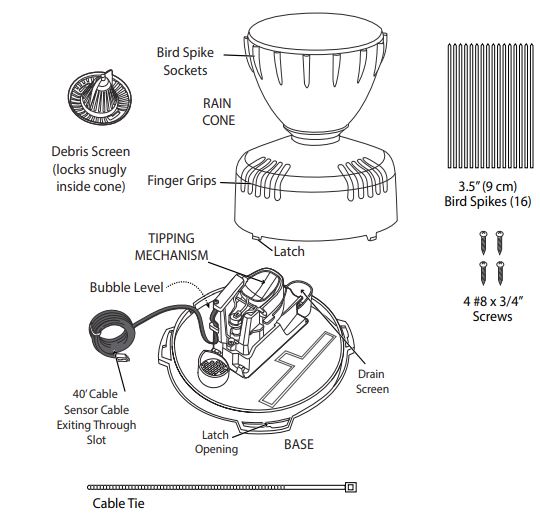
Tools and Materials NeededYou may need some of the following tools and materials to install the rain collector.
- Wirecutter
- Drill with 3/32″ (2 mm) drill bit
- Medium Phillips screwdriver
- Cable clips or weather-resistant cable ties with screw holes or other means for mounting
- Small hammer
Prepare the Rain Collector
1. Turn the rain collector upside down. Remove the cone from the base by rotating the base until the latches on the cone line up with the latch openings in the base, then lifting the base away from the cone.
base until the latches on the cone line up with the latch openings in the base, then lifting the base away from the cone.
Tip: It might be easier to remove the cone if you steady it between your knees.
2. Carefully cut and remove the plastic tie which holds the tipping spoon in place during shipping. 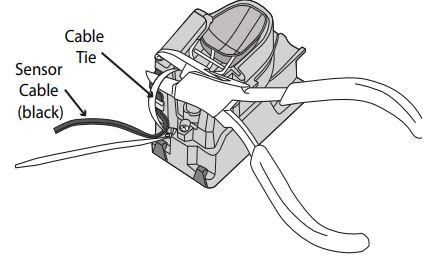
Note: Be careful to not accidentally cut the sensor cable.
Test the Rain CollectorBefore installing the rain collector, test the unit. If you are replacing a rain collector you previously installed, make a note of the total rainfall amount displayed. You may want to reenter this amount after you test the rain collector.
- Open the transmitter shelter on the sensor suite. Remove the foam insert from the cable port in the lower right corner and feed the rain collector cable up through the opening. Plug the cable into the appropriate connector in the sensor interface. (See illustration on page 5.)
- Press the RAIN DAY button on your console to display rainfall.
- While watching the display on your console to see if it changes, slowly tips thespoon until it drops and comes back up. Each tip indicates 0.01″ or 0.2 mm of rain. (It may take up to a minute for the first tip to register at the console.) If the display does not change, you may be tipping the spoon too quickly. Try again, more slowly this time. If the rainfall amount displayed on the console increases by the expected increment (either 0.01″ or 0.2 mm) each time you tip the spoon, your rain collector is working properly.
- When you have finished testing, separate the rain cone from the base and disconnect the rain collector cable from the sensor interface in the transmitter shelter.
Install the Rain Collector
Choose a LocationKeep the following in mind when choosing a location for your rain collector:
- For accurate readings, you must mount the rain collector so that it is level. A bubble level is built-in into the base to simplify this process.
- Be sure there is an unobstructed path for water runoff from the drain screens.
- The rain collector contains a magnet-operated switch which may not operate cor-recently if you mount the rain collector on or near any object which is attracted to a magnet.
- Exposure to winds can reduce the measured rainfall amounts. Mount the rain collector where there are no obstructions of rainfall at low angles — such as trees, houses, fences — and as low as possible out of the wind.
- Choose a location that is easily accessible for normal cleaning and is distant from trees or other sources of heavy pollen or debris.
Note: Climbing on your roof may be hazardous. If you are uneasy about installing your unit please have a qualified professional complete the installation. Davis specifically disclaims any liability for injury or loss resulting from the installation or use of the rain collector.
- Remove the rain collector cone if it is installed.
- Place the base on the mounting surface and mark the location of the four holes(the base has eight to choose from) you will use to secure the base.
- Make pilot holes using a 3/32″ (2 mm) drill bit. You should make the pilot holesabout 1/2″ (12 mm) deep.

- Fasten the base to the mounting surface using the #8 x 3/4″ screws provided.
- If using a Vantage Pro2 sensor suite or a Sensor Transmitter, open the transmitter shelter on the sensor suite. Remove the foam insert and feed the rain collector cable up through the opening. Plug the cable into the receptacle labeled RAIN. Replace the foam and close the shelter. If using an EnviroMonitor Node, follow the installation directions on your EnviroMonitor setup app.

- To be certain the rain collector is functioning properly after installation, retest. See “Test the Rain Collector” on page 2.
- Place the cone back onto the base by putting the latches on the cone into the latch
 openings in the base and rotating the cone clockwise until the latches “lock” into place. As you reattach the cone, make sure to run the cable through the cable slot in the base, or the cone will not fit snugly against the base.
openings in the base and rotating the cone clockwise until the latches “lock” into place. As you reattach the cone, make sure to run the cable through the cable slot in the base, or the cone will not fit snugly against the base. - To use bird spikes, insert one spike into each socket around the rim of the cone. The sockets are Debris tapered: push firmly or tap lightly with a hammer for a more secure fit. Be careful: bird spikes are Locking Grooves sharp.
- Place the debris screen, pointed end up, into the cone. Align the locking grooves with the locks inside the cone and turn to lock the screen in place. Finger If bird nesting is a problem, you can place spike grips in the hole on top of the debris screen. If you choose not to install bird spikes, keep the packet of spikes for possible future use.
- To prevent fraying or cutting of the cable where it is exposed to weather, it is important that you secure it so it doesn’t whip about in the wind. Use cable clips or weather-resistant cable ties to secure the cable. Place clips or ties approximately every 3 to 5 feet (1 to 1.6 m). Do not use metal staples or a staple gun to secure cables. Metal staples, especially when installed with a staple gun, have a tendency to cut the cables.
Extending Cable RunsIf the cable length supplied with the rain collector is not long enough for your purposes, you may extend it. The maximum length of cable is 900 feet (274 m). To extend the cable, purchase standard 4-Conductor Extension Cables from Davis and connect them to the existing rain collector cable.
Maintaining the Rain Collector
For the greatest accuracy, you should thoroughly clean the rain collector at least once or twice a year.
- Disconnect the rain collector cable from the sensor interface in the transmitter.
- Separate the cone from the base.
- Use a soft damp cloth to clean pollen, dirt, and other debris from the cone, drainscreens, and spoon.
- Use a pipe cleaner to clear the funnel hole in the cone and the drain screens in thebase. When all parts are clean, rinse with clear water.
- Reattach the cone and replace the debris screen. Reconnect the rain collector cable to the sensor interface.
Troubleshooting Guide
? Rainfall is not registering on the console or the console has a large error.
- Check the cable connections from the sensor to the transmitter. Cable connections account for a large portion of the potential problems. Connections should be firmly seated in the jacks and plugged in straight. If a reading appears intermittently on the display as you jiggle the cable, the connection is faulty.
- Make sure there is no magnetic, steel, or iron object near the rain collector.
- Make sure the funnel hole in the cone is clear so water can empty into the spoon.
- Make sure the spoon moves freely and comes back up when tipping. The consoleshould show an increase in rainfall for each tip of the spoon. (If the spoon does not move at all, check to make sure you have cut the cable tie that held it in place during shipping.)
- Make sure the rain collector is mounted so that it is level.
Contacting Davis Technical Support
If you have questions about your rain collector, or encounter problems installing or operating it, please contact Davis Technical Support.
Note: Please do not return items to the factory for repair without prior authorization.
Online: www.davisinstruments.com See copies of user manuals, product specifications, application notes, software updates, and more.E-mail: [email protected]Telephone: (510) 732-7814Monday Friday, 7:00 a.m. 5:30 p.m. Pacific Time
Specifications
Sensor Type. . . . . . . . . . . . . . . . . . . . . Tipping spoon with magnetic switchOutput . . . . . . . . . . . . . . . . . . . . . . . . . Contact closureAttached Cable . . . . . . . . . . . . . . . . . . 40′ (12 m), 4-conductor, 26 AWGConnector . . . . . . . . . . . . . . . . . . . . . . Modular connector (RJ-11)Recommended Max.Cable Length . . . 900′ (270 m)Housing Material . . . . . . . . . . . . . . . . . UV-stabilized ABS plasticDimensions with base, no spikes. . . . . 8.75″ wide x 9.5″ high (22.2 x 24 cm)Collection Area . . . . . . . . . . . . . . . . . . . 33.2 in2 (214 cm2)RangeDaily Rainfall . . . . . . . . . . . . . . . . . 0.00″ to 99.99″ (0.0 mm to 999.8 mm)Total Rainfall. . . . . . . . . . . . . . . . . . 0.00″ to 199.99″ (0.0 mm to 6553 mm)Accuracy . . . . . . . . . . . . . . . . . . . . . . . .For rain rates up to 2″/hr (50 mm/hr): ±4% of total or +0.01″ (0.2mm) (0.01″ = one tip of the spoon) whichever is greater.Update Interval . . . . . . . . . . . . . . . . . . . .20 – 24 secondsInput/Output Connections Red . . . . . . . . . . . . . . . . . . . . . . . . .Switch terminalGreen & Yellow . . . . . . . . . . . . . . . .Switch terminal
Product Number: 6464 6464M Rain Collector Part Number: 07395.366 Rev A (3/6/19) This product complies with the essential protection requirements of the EC EMC Directive 2004/108/EC. Vantage Pro and EnviroMonitor are registered trademarks of Davis Instruments, Hayward, CA. Copyright © 2019 Davis Instruments Corp. All rights reserved. Davis Instruments Quality Management System is ISO 9001 certified. Information in this document is subject to change without notice.

3465 Diablo Avenue, Hayward, CA 94545-2778 U.S.A.510-732-9229 · Fax: 510-732-9188E-mail: [email protected]www.davisinstruments.com
References
[xyz-ips snippet=”download-snippet”]

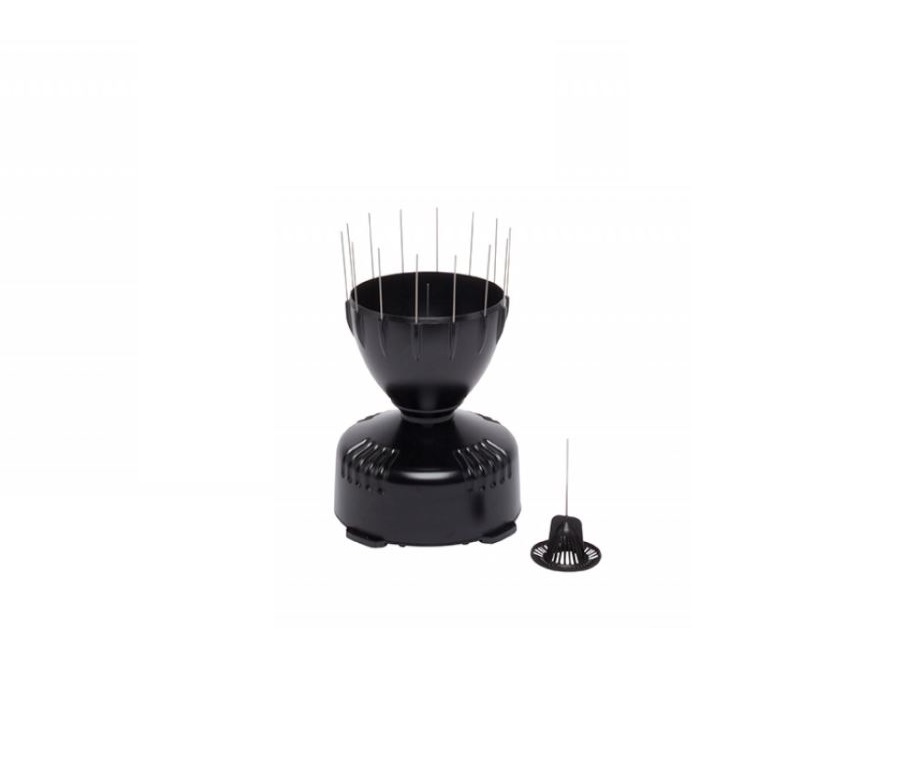
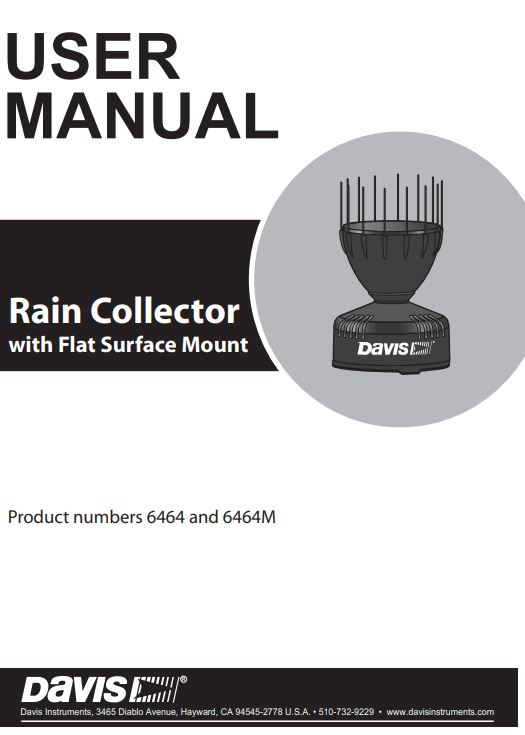
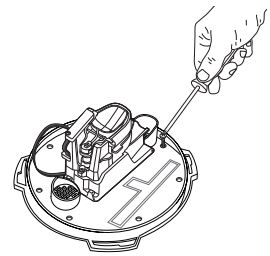
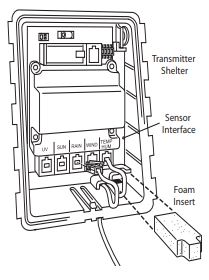
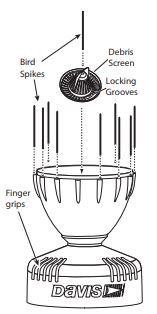 openings in the base and rotating the cone clockwise until the latches “lock” into place. As you reattach the cone, make sure to run the cable through the cable slot in the base, or the cone will not fit snugly against the base.
openings in the base and rotating the cone clockwise until the latches “lock” into place. As you reattach the cone, make sure to run the cable through the cable slot in the base, or the cone will not fit snugly against the base.